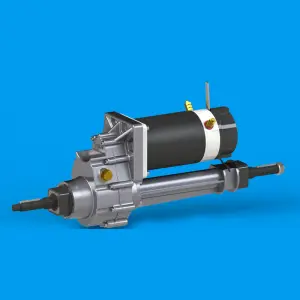The transaxle is a critical component in a vehicle’s drivetrain, responsible for transmitting power from the engine to the wheels. It combines the functions of a variable-speed transmission and a differential that distributes power to the wheels. The transaxle case contains several critical components that work together to ensure smooth and efficient transfer of power from the engine to the wheels.
The transaxle case is the housing that encloses the internal components of the transaxle. It is usually made of durable metal that can withstand the forces and stresses of the driveline. Within the transaxle housing, there are several important components that play a vital role in the operation of the transaxle.
The gearbox is one of the main components installed in the transaxle box. The transmission is responsible for changing gears to match the vehicle’s speed and load conditions. It contains a series of carefully synchronized gears and shafts to ensure smooth shifting and efficient power transfer. The transmission within the transaxle case is a key component in controlling vehicle speed and torque output.
Another important component within the transaxle case is the differential. The differential is responsible for distributing power from the transaxle to the wheels while allowing them to spin at different speeds, such as when cornering. It consists of a set of gears that enable the wheels to spin at different speeds while maintaining power distribution. The differential within the transaxle housing is critical to ensuring smooth and stable handling of the vehicle.
In addition, the transaxle case also contains the final drive assembly. This assembly consists of gears that further transfer power from the transaxle to the wheels. The final drive gears are engineered to provide the proper ratio for the vehicle’s speed and load conditions. The final drive assembly within the transaxle case plays a key role in determining the overall performance and efficiency of the vehicle.
The transaxle case also houses a lubrication system, which is critical to ensuring smooth operation and longevity of the internal components. The lubrication system consists of a pump, filter and reservoir that work together to provide a continuous supply of oil to the transmission, differential and final drive gears. Proper lubrication within the transaxle case is critical to reducing friction, dissipating heat and preventing premature wear of internal components.
Additionally, the transaxle case contains various seals and gaskets that help prevent leaks and maintain the integrity of the internal components. These seals and gaskets are designed to withstand the high pressure and temperature found within the transaxle case, ensuring the lubrication system remains effective and protecting internal components from contamination.
In summary, the transaxle case contains several key components that are critical to the smooth and efficient operation of your vehicle’s driveline. From the transmission and differential to the final drive assembly and lubrication system, each component plays a vital role in ensuring the efficient transfer of power from the engine to the wheels. Proper maintenance and care of the transaxle case and its internal components is critical to the overall performance and longevity of your vehicle. Understanding the components inside the transaxle case can help owners understand the complexity of the driveline and the importance of regular maintenance to ensure smooth and reliable operation.
Post time: Jul-05-2024


